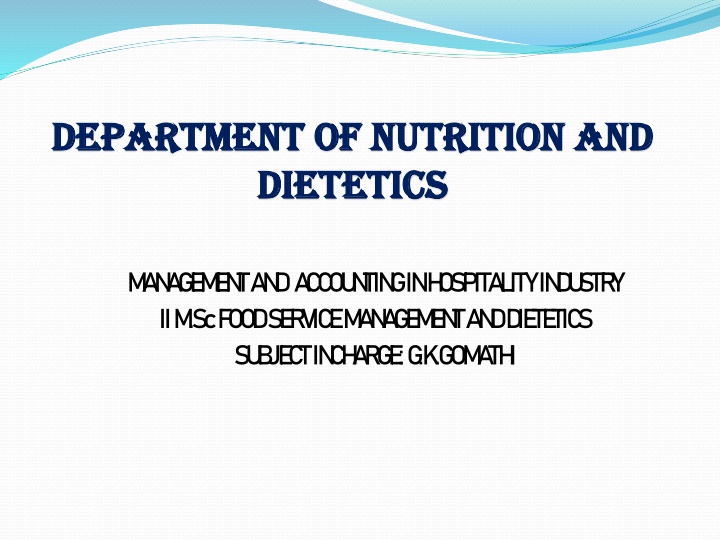
Effective Cost Control Strategies in Hospitality Industry
Learn about cost control strategies in the food and beverage industry, including cost concepts, types of costs, and techniques for managing costs. Explore the importance of comparing cost to sales ratios and implementing control techniques to regulate costs effectively.
Download Presentation

Please find below an Image/Link to download the presentation.
The content on the website is provided AS IS for your information and personal use only. It may not be sold, licensed, or shared on other websites without obtaining consent from the author. If you encounter any issues during the download, it is possible that the publisher has removed the file from their server.
You are allowed to download the files provided on this website for personal or commercial use, subject to the condition that they are used lawfully. All files are the property of their respective owners.
The content on the website is provided AS IS for your information and personal use only. It may not be sold, licensed, or shared on other websites without obtaining consent from the author.
E N D
Presentation Transcript
DEPARTMENT OF NUTRITION AND DEPARTMENT OF NUTRITION AND DIETETICS DIETETICS M A N A G E M E N T A N D A C C OU N TIN G IN H OSPITA L ITY IN D U STRY II M .Sc FOOD SE R VIC E M A N A G E M E N T A N D D IE TE TIC S SU B JE C T IN C H A RG E : G .K.G OM A TH I
FOOD COST AND BEVERAGE COST INTRODUCTION: Successful restaurent personnel, including chef, restaurent managers, food and beverage controllers, dinning room managers, and stewards have the ability to keep cost at predetermined levels. They understand that successful operations require that costs be carefully established and monitored so that profit will result.
OBJECTIVES: Define the terms cost and sales. Define and provide an example of the following types of costs. Provide several examples illustrating monetary and nonmonetary sales concepts. Explain the value of comparing current cost to sales ratios with those for previous periods.
COST CONCEPTS: ACCOUNTANTS: Define a cost as a reduction in the value of an asset for the purpose of securing benefit or gains. FIXED COST: Fixed cost are thosethat are normally unaffected by changes in sales volume. the term fixed should never taken to mean static or unchanging but merely to indicate that any changes that may occur in such cost.
VARIABLE COST: Variable cost are those that are clearly related to business volume. As business volume increase, variable cost will increase and vice versa. PAYROLL COST: Payroll cost includes salaries and wages and employee benefits and often referred as labor cost.
DEFINITION: COST CONTROL: Cost control defined as the process used by managers to regulate cost and guard against excessive costs. It is an ongoing process throughout the operation.
CONTROL TECHNIQUES: Establishing standard: standard are defined as rules or measures established for making comparisons and judgments. Establishing procedures: Procedures are the method employed to prepare products or perform jobs. example: production procedures must be standardized for several reasons. One of the most important of these is customer satisfaction.
FOOD PURCHASHING CONTROL: RESPONSIBILITY OF PURCHASHING: The responsibility of purchasing can be delegate to any one in the food service operation depending on organizational structure and management policies. PERISHABLE: Perishable are those items, typically fresh foods, that have a comparatively short useful life after they have been received. Should be purchased for immediate use only as they deteriorate quickly.
NON-PERISHABLE: Non perishable are those food items that have a longer shelf life. Often referred to as groceries or staple.They may be stored in the containers in which they are received, stored on shelf at room temperature for weeks or months.
FOOD PRODUCTION CONTROL: PORTIONS: Ingredients proportions of ingredients production methods quantity standard portion size standard recipe standard portion cost
OPTIMIZING NUMBER OF SALES: Location menu item price acceptability lighiting portion sizes product quality service standards menu diversity
MAXIMIZING PROFIT: THE MENU: Layout and design variety item arrangement and location descriptive language kitchen personnel and equipment SALES TECHNIQUES: Up-selling menu knowledge
BEVERAGE PRODUCTION CONTROL: To ensure that all drinks are prepared accordingly to managements specifications. To guard against excessive costs that can develop in the production process.
ESTABLISHING STANDARDS AND STANDARD PROCEDURES FOR PRODUCTION: Standard must be established for the: quantity of the ingredients used proportion of the ingredients used drink sizes To have some reasonable assurance that a drink will meet expectations each time it is ordered.
CONTROLLING REVENUE: POSSIBLE CONTROL OF PROBLEMS: Working with the cash drawer open Under-ringing sales Overcharging customer Undercharging customer Over pouring Under pouring Drinking on the job
BEVERAGE SALES MONITORING: THE COST APPROACH: Cost percentage methods Monthly calculation Daily cost calculation Cost calculation by category THE LIQUID MEASURE APPROACH: ounce Inventory turnover.
